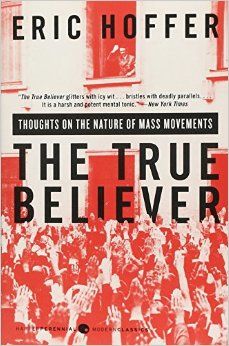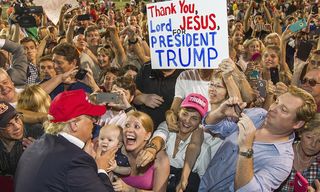Religion
Fervor and Fanaticism
The parallels between Trumpism and other mass movements
Posted March 12, 2017

“Mass movements do not usually rise until the prevailing order has been discredited,” writes Eric Hoffer in his 1951 classic The True Believer. Once underway, that discrediting tends to be systematic and wholesale: it glorifies the past to belittle the present, and stokes “intense dissatisfaction with things as they are” to nurse a range of fanatical grievances and their imagined solution.
The best-selling, critically acclaimed, and self-taught author—sometimes dubbed the “longshoreman philosopher” because he worked as a stevedore on the San Francisco docks in the 1940s—came to these conclusions after analyzing the sharp rise in nationalist sentiment and activity a decade earlier, in countries as far-flung as Japan and Germany, the Soviet Union and Turkey. Much of Hoffer’s focus dwells on the grievances (real and imagined) fueling resentment among those countries’ working poor, of the kind that later morphed into political and religious fanaticism, granting the movements they formed resilience and widespread popular support.
A second characteristic of that channeled resentment, according to The True Believer, in ways that accord with my previous post on “Authoritarianism in America”? “There can be no mass movement without some deliberate misrepresentation of facts.” The systematic discrediting of facts and consensus goes hand-in-glove with the undermining of institutions such as the press and the courts: This is “not an automatic result of the blunders and abuses of those in power,” he warns, “but the deliberate work of men of words with a grievance.” So begins what the author of nine other wide-ranging books called “the preliminary work of undermining existing institutions, of familiarizing the masses with the idea of change, and of creating a receptivity to a new faith.”

It is a bracing, unsettling moment in a book that has much to say about our own national moment (including the discrediting of institutions) and much to warn us about its broader implications and dangers. Hoffer’s analysis can suddenly jump years and locations, in ways that seem to describe not just nationalism and mass grievances in the 1930s but those dominant in 2016 and today.
“For men to plunge headlong into an undertaking of vast change,” he writes of the heedless, wreck-it-if-necessary attitude that can take over at such moments, “they must be intensely discontented yet not destitute, and they must have the feeling that by the possession of some potent doctrine, infallible leader or some new technique they have access to a source of irresistible power.” Much of the book’s analytical power and disturbing relevance stems from its desire to understand how such promises can serve as “an opiate for the frustrated,” in ways that urge not dismissal or contempt but rather identification with the “disinherited and dispossessed”—those who feel “discarded and rejected,” whose frustration may be just yet misdirected and manipulated.

Much is made of the “electrifying conviction” with which the Bolsheviks in Russia, the National Socialists in Germany, and extremists elsewhere set about transforming high levels of discontent and disaffection into causes able to galvanize and “bewitch” millions of followers. As Hoffer shows in a broad-based analysis, they turned resentment and despair into the basis for zealotry and the pursuit of fanatical ideals, in which the scramble for national pre-eminence became so urgent and intoxicating that even mass incarceration and genocide could seem reasonable byproducts.
In a climate propelled by such hatred and despair, the one seeking to lead it bears responsibility for the paths it takes. According to Hoffer, the designated or chosen leader tries to “articulate and justify the resentment dammed up in the souls of the frustrated. He kindles the vision of a breathtaking future so as to justify the sacrifice of a transitory present. He stages the world of make-believe so indispensable for the realization of self-sacrifice and united action.” Any of this sound familiar?
Exceptional intelligence and nobleness of character aren’t necessary in such a leader, Hoffer posits. What’s needed, rather, are
boundless self-confidence…, audacity, and a joy in defiance; an iron will; a fanatical conviction that he is in possession of the one and only truth; faith in his destiny and luck; a capacity for passionate hatred; contempt for the present; a cunning estimate of human nature; a delight in symbols (spectacles and ceremonials); unbounded brazenness which finds expression in a disregard of consistency and fairness; a recognition that the innermost craving of a following is for communion and that there can never be too much of it; a capacity for winning and holding the utmost loyalty of a group of able lieutenants.
Hoffer published these words in 1951 and died in 1983, several months after receiving the Presidential Medal of Freedom. According to his biographer, he nonetheless feared the rise of an American version of Hitler. And though his model of nationalism best explains the rapid ascent of secular versions in Germany, Japan, Turkey, and the Soviet Union, Hoffer had much to say about what was specific about U.S. nationalism—centrally, its religious component. He was, after all, writing at a time of nationwide stress on religious sentiment, when religiosity was frequently described as one of the country’s defining characteristics.
Hoffer described this transformation of U.S. society as a type of “religiofication,” a buzzword for what he shrewdly dubbed the “art of turning practical purposes into holy causes.” In the 1950s, those often took the form of “crusades” for major cities such as for Atlanta, Los Angeles, New York, and Washington, D.C., described at the time as godless and immoral. “Where unity and self-sacrifice are indispensable for the normal functioning of society,” Hoffer warned of countries prone to nationalist fervor, including the U.S., “everyday life is likely to be either religiofied (common tasks turned into holy causes) or militarized.” According to such reasoning—and political developments would soon confirm this, underscoring the accuracy of his thesis—it was no accident that the “military-industrial complex” prized by the Eisenhower administration morphed into what has since been called its “spiritual-industrial complex,” including the crusade for piety and patriotism over Communism. It was Eisenhower who declared, “Recognition of the Supreme Being was the first—the most basic—expression of Americanism.” And “Without God, there would be no American form of Government, nor an American way of life.”
These statements represent the years immediately following the publication of The True Believer, when the United States saw an unprecedented “surge of piety” and ministers such as Norman Vincent Peale (friend to Eisenhower and, for many years, the current president) spoke openly of wanting to give Americans “enthusiasm for Christian world conquest.” They did so, my latest book describes, through a self-named “religio-psychiatry” movement and organizations such as the American Foundation of Religion and Psychiatry, which evangelized to large swaths of American industry and campaigned to make religious sentiment a sign of mental health and upstanding citizenship rather than, as more commonly, one of their possible consequences.

Hoffer’s clear-eyed grasp of political and religious fanaticism made him pragmatic about how best to defeat it. “When we debunk a fanatical faith or prejudice,” he warned, “we do not strike at the root of fanaticism. We merely prevent its leaking out at a certain point, with the likely result that it will leak out at some other point.” His best example about the blind faith characterizing mass movements concerns the Soviet Union and the fantasies projected onto it from within and without:
The fanatical Communist refuses to believe any unfavorable report or evidence about Russia, nor will he be disillusioned by seeing with his own eyes the cruel misery inside the Soviet promised land. It is the true believer’s ability to “shut his eyes and stop his ears” to facts that do not deserve to be either seen or heard which is the source of his unequaled fortitude and constancy. He cannot be frightened by danger, nor disheartened by obstacles, nor baffled by contradictions because he denies their existence. (My emphasis)
Against a mindset fueled by such certainty, where danger raises no flags and contradictions are readily brushed aside, confrontation is rarely successful and changes few minds. The best way to end such fanaticism, Hoffer posits, is to find ingenious ways to redirect it, including to less harmful and extreme ends. There must, however, be a functioning political alternative—one that can address and try to disperse the massive cloud of grievance and frustration that has accumulated, to make modernization and social reform once more seem reasonable and attractive goals.
christopherlane.org Follow me on Twitter @christophlane
References
Hoffer, E. (1951, rept. 2010). The True Believer: Thoughts on the Nature of Mass Movements. New York: HarperPerennial.
Lane, C. (2016). Surge of Piety: Norman Vincent Peale and the Remaking of American Religious Life. New Haven: Yale UP.




